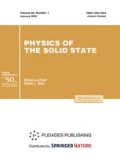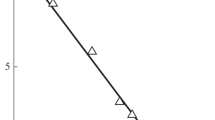Abstract
A theoretical model that interprets the increase in the elastic modulus of carbon nanotube fibers upon the formation of π–π cross links between individual nanotubes in the fiber is proposed. It is shown that the following three factors affect the elastic modulus of a fiber: the elastic modulus of the initial nanotubes; the degree of interaction between individual nanotubes in the fiber; and its aspect ratio, i.e., the ratio of the fiber length to its diameter. At the point of transition of these interactions from repulsion to attraction, the elastic modulus of the fiber reaches the corresponding value for an individual carbon nanotube and exceeds it in the region of attractive interactions. The basic factor for the rigidity of carbon nanotube fibers is their structure, which is characterized by fractal dimension.



Similar content being viewed by others
REFERENCES
A. V. Eletskii, Phys. Usp. 50, 225 (2007).
A. Mikhalchan and J. J. Vilatela, Carbon 150, 191 (2019).
X. Zhang, K. Jiang, C. Feng, P. Liu, L. Zhang, and J. Kong, Adv. Mater. 18, 1505 (2006).
W. Ma, L. Liu, R. Yang, T. Zhang, and L. Song, Adv. Mater. 21, 603 (2009).
X. Liang, Y. Gao, J. Duan, Z. Liu, S. Fang, R. H. Baughman, L. Liang, and Q. Cheng, Carbon 150, 268 (2019).
S. Boncel, R. M. Sundaram, A. H. Windle, and K. K. K. Koziol, ACS Nano 5, 9339 (2011).
K. Liu, Y. H. Sun, X. Y. Lin, R. F. Zhou, J. P. Wang, and S. S. Fang, ACS Nano 4, 5827 (2010).
Y. O. Im, S. H. Lee, T. Kim, J. Park, J. Lee, and K. H. Lee, Appl. Surf. Sci. 392, 342 (2017).
X. Lu, N. Hiremathi, K. Hong, M. C. Evora, V. H. Ranson, and A. K. Naskar, Nanotechnology 28, 145603 (2017).
G. V. Kozlov, P. G. Rizvanova, I. V. Dolbin, and G. M. Magomedov, Russ. Phys. J. 62, 127 (2019).
L. B. Atlukhanova and G. V. Kozlov, Physicochemistry of Nanocomposites Polymer-Carbon Nanotubes (Sputnik+, Moscow, 2020) [in Russian].
D. Blond, V. Barron, M. Ruether, K. P. Ryan, V. Nicolosi, W. J. Blau, and J. N. Coleman, Adv. Funct. Mater. 16, 1608 (2006).
A. K. Mikitaev and G. V. Kozlov, Phys. Solid State 57, 974 (2015).
G. V. Kozlov, I. V. Dolbin, Yu. N. Karnet, and A. N. Vla-sov, Nanosci. Technol. 11, 275 (2020).
Author information
Authors and Affiliations
Corresponding author
Ethics declarations
The authors declare that they have no conflicts of interest.
Additional information
Translated by O. Kadkin
Rights and permissions
About this article
Cite this article
Kozlov, G.V., Dolbin, I.V. Influence of Transverse π–π-Bridging on Formation Properties of High-Modulus Carbon Nanotube Fibers. Phys. Solid State 64, 193–196 (2022). https://doi.org/10.1134/S1063783422050031
Received:
Revised:
Accepted:
Published:
Issue Date:
DOI: https://doi.org/10.1134/S1063783422050031




